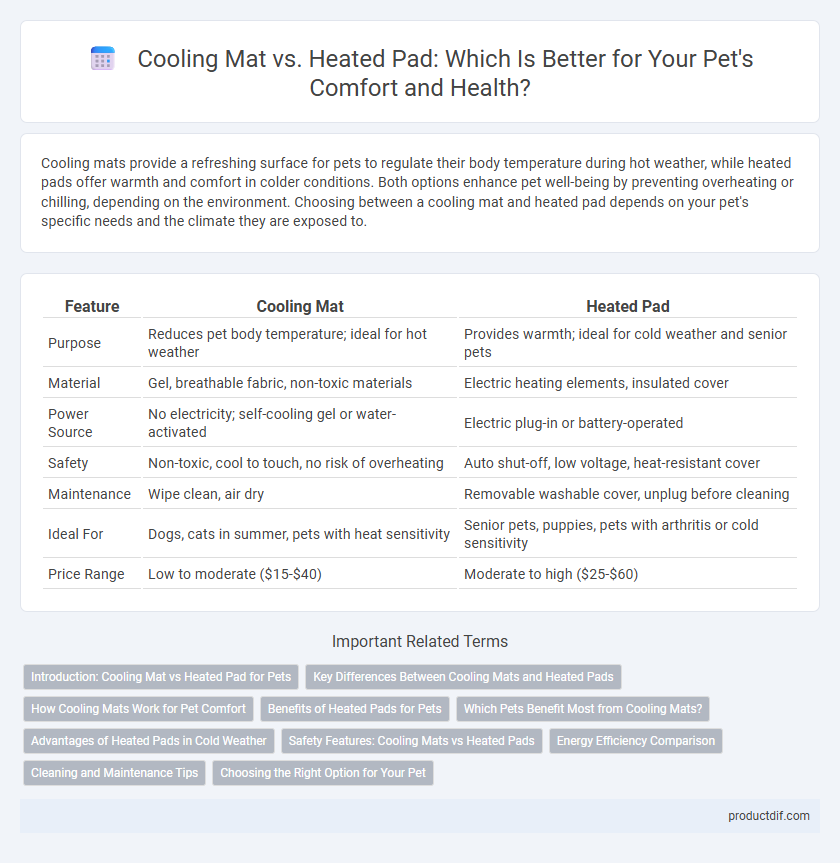Cooling mats provide a refreshing surface for pets to regulate their body temperature during hot weather, while heated pads offer warmth and comfort in colder conditions. Both options enhance pet well-being by preventing overheating or chilling, depending on the environment. Choosing between a cooling mat and heated pad depends on your pet's specific needs and the climate they are exposed to.
Table of Comparison
| Feature | Cooling Mat | Heated Pad |
|---|---|---|
| Purpose | Reduces pet body temperature; ideal for hot weather | Provides warmth; ideal for cold weather and senior pets |
| Material | Gel, breathable fabric, non-toxic materials | Electric heating elements, insulated cover |
| Power Source | No electricity; self-cooling gel or water-activated | Electric plug-in or battery-operated |
| Safety | Non-toxic, cool to touch, no risk of overheating | Auto shut-off, low voltage, heat-resistant cover |
| Maintenance | Wipe clean, air dry | Removable washable cover, unplug before cleaning |
| Ideal For | Dogs, cats in summer, pets with heat sensitivity | Senior pets, puppies, pets with arthritis or cold sensitivity |
| Price Range | Low to moderate ($15-$40) | Moderate to high ($25-$60) |
Introduction: Cooling Mat vs Heated Pad for Pets
Cooling mats provide pets with a soothing surface that dissipates heat, ideal for hot climates and preventing overheating during summer. Heated pads offer gentle warmth to soothe aching joints and maintain comfort in colder environments, especially for elderly or sick pets. Choosing between a cooling mat and a heated pad depends on your pet's specific temperature needs, health status, and seasonal conditions.
Key Differences Between Cooling Mats and Heated Pads
Cooling mats use evaporative or gel-based materials to absorb and dissipate heat, providing relief from high temperatures by lowering a pet's surface temperature. Heated pads generate and maintain warmth through electric or self-warming technologies, ideal for keeping pets comfortable in colder environments. Key differences include their temperature regulation method, energy source, and suitability for either warm or cold weather conditions.
How Cooling Mats Work for Pet Comfort
Cooling mats use phase change materials or gel technology to absorb and dissipate heat from a pet's body, maintaining a lower surface temperature that provides relief during hot weather. These mats often contain non-toxic, pressure-activated materials that activate cooling effects when a pet lies down, enhancing comfort without the need for electricity or refrigeration. The cooling properties help regulate a pet's body temperature, reducing heat stress and promoting longer rest periods in warm environments.
Benefits of Heated Pads for Pets
Heated pads provide targeted warmth that helps alleviate arthritis and muscle stiffness in pets, improving their overall mobility and comfort. These pads maintain a consistent temperature, which supports healing of injuries and promotes better circulation. Suitable for older or sick pets, heated pads offer therapeutic benefits that enhance their quality of life during cold weather.
Which Pets Benefit Most from Cooling Mats?
Cooling mats provide optimal relief for pets with thick fur, brachycephalic breeds, and those prone to overheating during hot weather or physical activity. They are particularly beneficial for senior dogs and cats suffering from joint pain or arthritis, as the cooling effect helps reduce inflammation. Pets living in warm climates or with heat-sensitive health conditions experience improved comfort and safety using cooling mats.
Advantages of Heated Pads in Cold Weather
Heated pads provide consistent warmth that helps maintain optimal body temperature for pets during cold weather, reducing the risk of hypothermia and joint stiffness. They promote improved circulation and comfort, especially for older or sick animals that struggle to regulate their body heat naturally. Unlike cooling mats, heated pads create a cozy environment that supports recovery and relaxation in chilly conditions.
Safety Features: Cooling Mats vs Heated Pads
Cooling mats utilize non-toxic gel materials and often feature bite-resistant covers to prevent leaks, ensuring pet safety during use. Heated pads incorporate automatic shut-off mechanisms and temperature regulators to avoid overheating and burns, providing controlled warmth for pets. Both products prioritize safety by using durable, pet-friendly materials designed to withstand chewing and prevent hazards.
Energy Efficiency Comparison
Cooling mats utilize phase change materials that absorb heat, offering efficient temperature regulation without electricity, making them highly energy-saving. Heated pads require constant electrical power to maintain warmth, resulting in higher energy consumption and increased utility costs. For pet owners prioritizing energy efficiency and sustainability, cooling mats present a more eco-friendly alternative compared to electric heated pads.
Cleaning and Maintenance Tips
Cooling mats require simple cleaning with mild soap and water to prevent buildup of dirt and bacteria, ensuring longevity and hygiene. Heated pads often need extra care, such as checking electrical components before cleaning and avoiding submersion to maintain safety and functionality. Regular inspection of seams and cords on both products helps prevent damage and keeps pet comfort reliable.
Choosing the Right Option for Your Pet
Cooling mats are ideal for pets prone to overheating or those with thick fur, offering temperature regulation during hot weather. Heated pads provide comfort and relief for pets with arthritis or muscle pain, maintaining warmth in colder environments. Consider your pet's specific health needs and environmental conditions to select the optimal product for their well-being.
Cooling Mat vs Heated Pad Infographic

 productdif.com
productdif.com